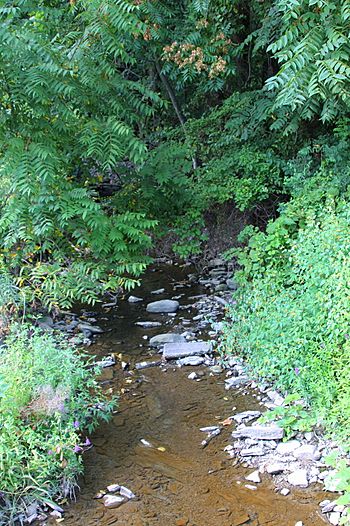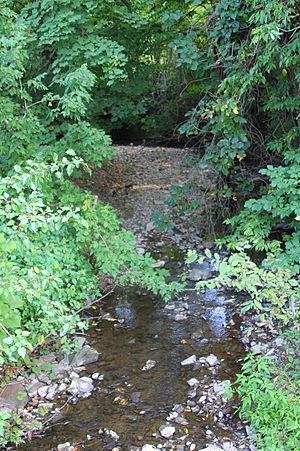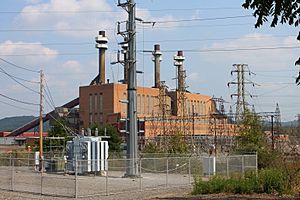Rolling Green Run facts for kids
Quick facts for kids Rolling Green Run |
|
|---|---|

Rolling Green Run looking downstream in its lower reaches
|
|
| Physical characteristics | |
| Main source | small valley in Monroe Township, Snyder County, Pennsylvania between 780 and 800 feet (240 and 240 m) |
| River mouth | Susquehanna River in Hummels Wharf in Monroe Township, Snyder County, Pennsylvania 410 ft (120 m) 40°49′58″N 76°49′41″W / 40.83275°N 76.82811°W |
| Length | 3.3 mi (5.3 km) |
| Basin features | |
| Progression | Susquehanna River → Chesapeake Bay |
| Basin size | 2.04 sq mi (5.3 km2) |
| Tributaries |
|
Rolling Green Run is a small stream, also called a tributary, that flows into the big Susquehanna River in Snyder County, Pennsylvania. It's about 3.3 miles (5.3 km) long and runs through Monroe Township. The area of land that drains into this stream, called its watershed, is about 2.04 square miles (5.3 km2).
Sadly, parts of the stream are considered 'impaired' because golf courses have changed its natural environment. Even so, its watershed is a good place for 'Warmwater Fish' and 'Migratory Fish' to live. This means it supports fish that like warmer water and fish that travel long distances.
Contents
Where Does Rolling Green Run Flow?
Rolling Green Run starts in a small valley in Monroe Township. It flows west for a short distance before entering a larger valley. In this valley, the stream turns and flows south-southeast, then southeast.
Further downstream, it leaves the valley and gets water from two smaller streams, called unnamed tributaries. It then enters the town of Hummels Wharf. In Hummels Wharf, the stream turns south-southeast again.
It crosses a major road, US Route 11/US Route 15, and then turns northeast. The stream flows next to the Susquehanna River for a short distance before finally joining it. Rolling Green Run meets the Susquehanna River about 121.78 miles (196.09 km) from where the Susquehanna River ends.
What About the Water Quality?
About 2.5 miles (4.0 km) of streams in the Rolling Green Run watershed are considered 'impaired'. This means the water quality isn't as good as it should be. The main reason for this problem is changes to the natural environment, mostly caused by nearby golf courses.
A company called Sunbury Generation LP used to be allowed to release water from its operations into the stream. This included water used to clean out ash and water from storms.
How High is the Stream?
The land around where Rolling Green Run joins the Susquehanna River is about 410 feet (120 m) above sea level. Where the stream begins, its source, the land is higher, between 780 and 800 feet (240 and 240 m) above sea level.
Long ago, Rolling Green Run used to flow into Penns Creek instead of the Susquehanna River. In the 1970s, some pipes that were 15 inches (38 centimeters) wide emptied into Rolling Green Run.
The Stream's Watershed
The watershed of Rolling Green Run covers an area of about 2.04 square miles (5.3 km2). The entire stream is located within the Sunbury area, as shown on maps from the United States Geological Survey. The stream is important for supporting aquatic life, which means plants and animals that live in the water.
There is a risk of small, local floods happening along Rolling Green Run.
A Look at History
Rolling Green Run was officially added to the Geographic Names Information System on August 2, 1979. This system keeps track of names and locations of places in the United States.
A bridge that carries State Route 1017 over Rolling Green Run was built in 1954. It is about 22.0 feet (6.7 m) long. In 2003, there was a plan to add new lanes to US Route 15, a major highway, and this project was expected to affect the stream.
Animals in the Water
The area that drains into Rolling Green Run is known as a 'Warmwater Fishery' and a 'Migratory Fishery'. This means it's a good place for fish that prefer warmer water, and also for fish that travel between different bodies of water.
The stream has special rules for fishing bass. These rules often mean that anglers must practice 'catch and release', where they catch the fish but then let it go back into the water.



